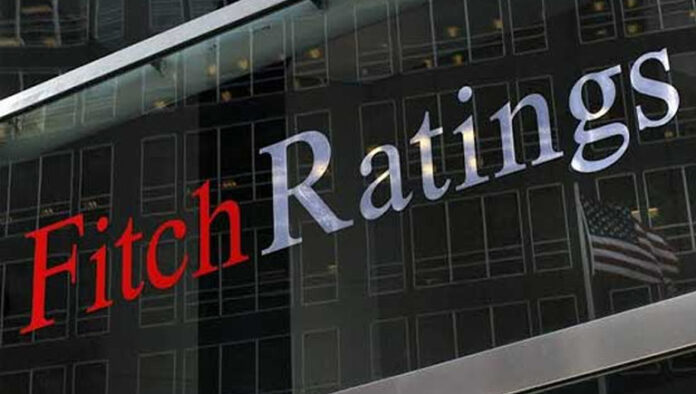In a significant development, Fitch Ratings has upgraded Pakistan’s Long-Term Foreign-Currency Issuer Default Rating (IDR) to ‘CCC+’ from ‘CCC’.
The global rating agency said in its latest report that the upgrade reflects greater certainty over the continued availability of external funding, in the context of Pakistan’s staff-level agreement (SLA) with the IMF on a new 37-month USD 7 billion Extended Fund Facility (EFF).
Fitch typically does not assign Outlooks to sovereigns with a rating of ‘CCC+’ or below.
“Strong performance on the previous, more temporary IMF arrangement helped the country narrow fiscal deficits and rebuild foreign exchange (FX) reserves, and further improvements are likely,” read the report.
“Nevertheless, Pakistan’s large funding needs leave it vulnerable if it fails to implement challenging reforms, which could undermine programme performance and funding,” it cautioned.
Pakistan and the IMF reached the SLA on 12 July. Before IMF Board approval, which “we assume by end-August, the government will have to obtain new funding assurances from bilateral partners, chiefly Saudi Arabia, the UAE and China, totalling about USD4 billion-5 billion over the duration of the EFF.”
“We believe this will be achievable, given the strong past record of support and significant policy measures in the recent budget for the fiscal year ending June 2025 (FY25).”
The government aims under the new EFF to tackle long standing structural weaknesses in Pakistan’s tax system, energy sector and state-owned enterprises, alongside a commitment to exchange rate flexibility and improvements in the monetary policy framework. It targets a 3pp increase in tax revenues/GDP, from under 9% in FY24, including through higher taxes on the country’s influential agricultural sector, which will have to be legislated at the provincial level.
The rating agency further said that Pakistan successfully completed its nine-month Stand-by Arrangement with the IMF in April. Over the past year, the government raised taxes, cut spending and raised electricity, gas and petrol prices. The government also eliminated the gap between the interbank and parallel market exchange rates through a crackdown on the black market and regulation of exchange houses.
Fitch forecasted that the current account deficit (CAD) to stay relatively contained at about $4 billion (about 1% of GDP) in FY25, after about $700 million in FY24, given tight financing conditions and subdued domestic demand.
Besides CADs, Pakistan faces over $22 billion in external public debt maturities in FY25. Of the total maturities, $13 billion is in the form bilateral deposits and loans that are regularly rolled over, including nearly $4 billion in liabilities of the State Bank of Pakistan (SBP). Maturing debt also includes nearly $4 billion from Chinese commercial banks, and $4 billion from multilateral creditors. Pakistan’s next international bond maturity is in September 2025.
“The government says it has identified over $24 billion in gross external financing, mostly from bilateral and multilateral sources, not including potential bond issuance or the renewal of the oil facility with Saudi Arabia, but including a potential Panda bond issuance,” Fitch added.
It further said that FDI and non-resident portfolio inflows and climate-related finance pose other upsides to the funding plan.
The SBP is rebuilding forex reserves amid inflows of new funding and limited CADs. “We estimate official gross reserves, including gold, rose to over $15 billion at June 2024, enough for three months of imports, from nearly $10 billion at end-June 2023, and we expect them to rise to nearly $22 billion by FYE26, close to their 2021 peak.”
The rating agency said that the SBP has reduced its forward liabilities to local banks and is approaching a balanced net foreign asset/liability position.
Fitch said that PMLN and its allies command only a slim majority in the National Assembly after a recent Supreme Court ruling re-allocating reserved seats in favour of independents linked with former prime minister Imran Khan’s PTI party. Mr Khan has been in prison since May 2023, but remains popular.
Before the recent SBA, governments from across the political spectrum in Pakistan have had a mixed record of IMF programme performance, often failing to implement or reversing the required reforms. The current apparent consensus within Pakistan on the need for reform could weaken once economic and external conditions improve, although Pakistan now has fewer financing options than in the past.
“We estimate government debt fell to 68% of GDP by FYE24, from 75% at FYE23, due to high inflation and deflator effects, offsetting soaring domestic interest costs. This is broadly in line with the B/C/D median,” the rating agency said in its report.
It anticipated that inflation and interest costs would decline in tandem, with economic growth and primary surpluses driving government debt/GDP gradually lower.
The rating agency said Pakistan has an ESG Relevance Score (RS) of ‘5’ for both political stability and rights and for the rule of law, institutional and regulatory quality and control of corruption, as is the case for all sovereigns.
“These scores reflect the high weight that the World Bank Governance Indicators (WBGI) have in our proprietary Sovereign Rating Model (SRM). Pakistan has a WBGI ranking at the 22nd percentile,” it added.




